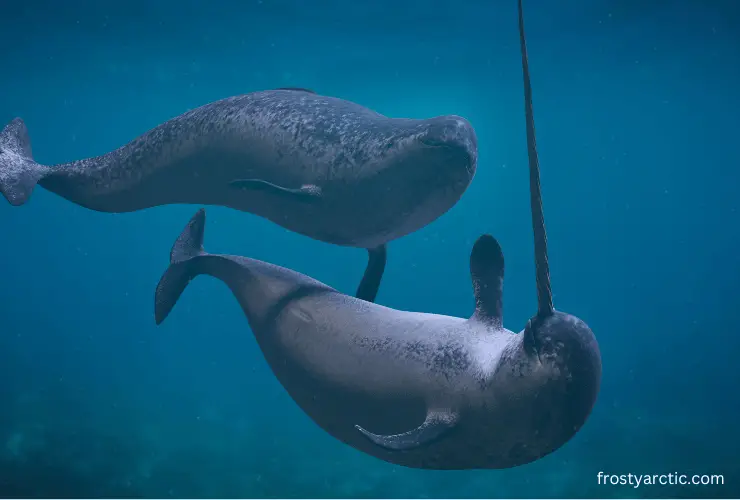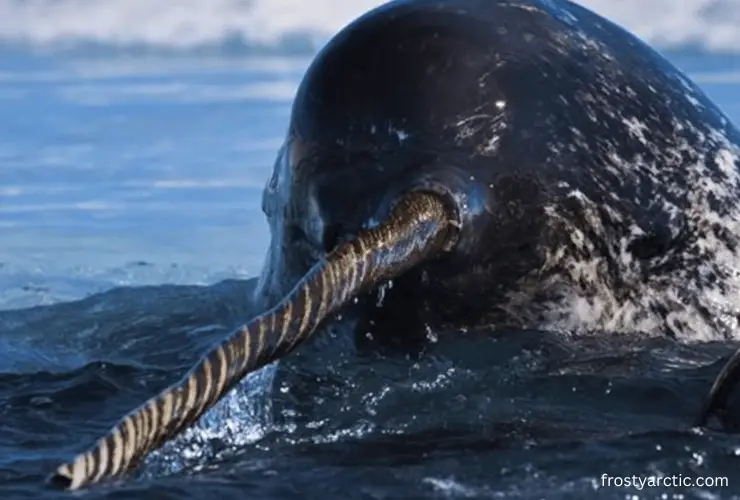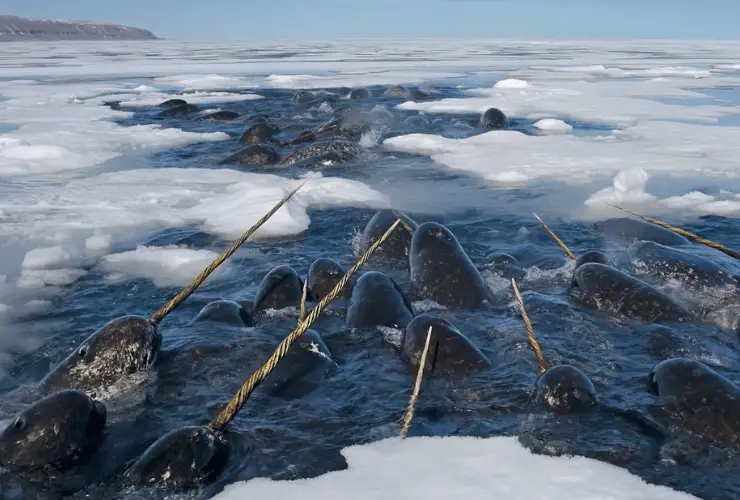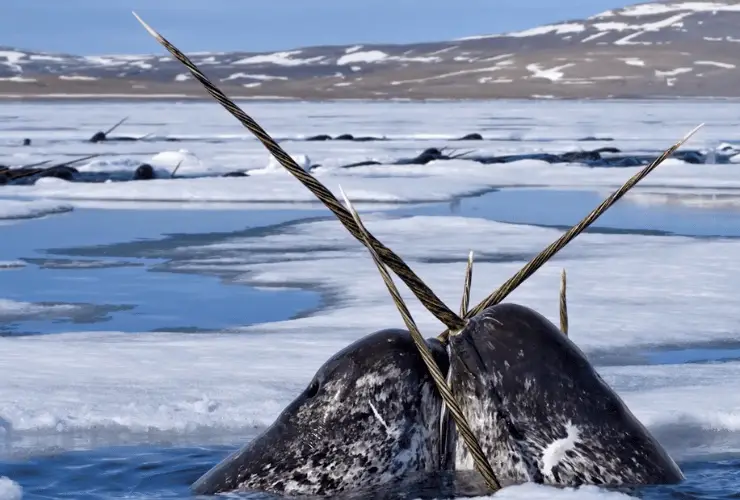Narwhals, marine mammals, have adapted to their Arctic habitat in several ways. They can better adapt to their habitat because of their thick layer of blubber, streamlined body shape, long/spiral tusks, and exceptional seasonal migration ability.
Their adaptability makes them more special and enjoyable. They face several risks and obstacles due to their habitat and survival requirements. They have unique physical features and behavioral patterns to overcome their problems. The most special is the ability to breathe through the narrow ice cracks, which the narwhals do in extreme winter.
These deep divers and survivors have unique survival needs that must be understood through a thorough discussion of the cold Arctic.
The Arctic marine environment is itself a challenge to all marine life. The climate is harsh, with extreme variations in light and temperature. The summers are short, and snow and ice cover are sudden.
Blubber, a thick layer of fat just beneath the skin, helps narwhals’ bodies withstand the cold. The layer of blubber keeps their bodies warm. The same layer also works as a cushion against hard and sharp surfaces.
Narwhals, like machines, can shut down all their functions that are needed for diving. When not diving, they stop those functions to preserve their energy and stay warm against the cold.
a) Behavioral adaptations of a narwhal

Narwhals are deep divers and also live deep in the ocean. This makes them a rare sight. However, they need to come up to the water’s surface to breathe. For that, They breathe through the ice cracks in groups. Their daily routine occasionally results in their deaths when they become stuck due to sudden freezing.
As deep divers, narwhals use this ability to dive into deep waters in search of prey. It was discovered that they could stay underwater for 800 meters and dive to a depth of 1800 meters.
Scientists believe that the feeding of narwhals is another adaptation.
The intense feeding period in winter and little feeding in ice-free summer may be because they avoid competing with the low-altitude whales or the low productivity in summer.
Research conducted in 2007 by Deitz and his colleagues established that narwhals spend 12% of their time swimming belly up to protect their lower jaws from increasing sonic reception range.
b) Physical adaptations of a narwhal
The narwhal’s body is well adapted to the above-mentioned environment. They have a streamlined body. The two dorsal flippers are there in the absence of a dorsal fin. The deep dives of narwhals require propulsion. This comes from their tail.
Living in deep water means they can take a lot of ocean pressure. An appropriately shaped rib cage that is compressed to allow the lungs to collapse and pass air into the trachea makes this possible.
In addition, the muscles have a high concentration of myoglobin to accommodate their increased oxygen requirements. The muscles have more swimming endurance than dolphins.
Do Narwhals Migrate or Hibernate? Let’s Explore the Reality

Narwhals aren’t dependent on night or day for swimming and living. They sleep and live in the ocean but do not hibernate. They don’t need to hibernate because they do not depend on brightness or darkness for survival.
They rely on hearing that sight while moving. They don’t sleep long and do it only when tired.
You must have heard about the narwhal pods. These pods essentially serve as ha safe migration route for migrating narwhals. They migrate, as evidenced by their movement along the coasts and passage through the fjords, at consistent times of the year.
Additionally, they move along the pack ice in March and April to regions inaccessible in the winter.
How Do Narwhals Adapt to Climate Change?

Climate change here means the change in temperature in the Arctic. This change results in ice melting at unexpected times of the year, resulting in threats to the narwhals.
The following is a glimpse of the apparent problems narwhals face due to climate change. Plus, you could also find the skilled narwhal adapting to problems with self-sufficient solutions:
Narwhals adapt to problems with self-sufficient solutions
Problem 1
The summertime migration of narwhal pods from north to south exposes them to expanding and receding ice. As the pods breathe through the ice cracks, flash ice freezing in late autumn causes the death of entire pods. However, this event has been observed for centuries, but now it has increased due to climate change.
Solution
Narwhals have been observed to modify and alter their migration patterns to avoid unsuitable areas for feeding and living.
Problem 2
The Arctic is experiencing noise pollution due to human invasions brought on by ice melting. This may be a threat to narwhals’ activities because they are sonar.
Solution
There is a possibility that the narwhals may modify their vocalizations to navigate through areas with increased noise pollution.
Problem 3
Due to the decline of winter ice cover, other species are encroaching upon the narwhal community. This increased competition for resources and food could result in a predatory threat.
Solution
Narwhalscan undergo changes to adjust feeding habits for survival if fish and squid are not available. This is also due to changes in the Arctic ecosystem.
Problem 4
Along with the climate, there are other things that are changing the environmental conditions for the narwhals. They have to face hindrances to live easily and reproduce.
Solution
Narwhals have genetic modifications over time to adapt to environmental changes. They learn that natural selection favors such individuals, which helps them survive and achieve reproductive success.
Frequently Asked Questions (Faqs)
How do the narwhals survive the predators?
Narwhals are hunted by polar bears and killer whales. They kill them when the narwhals are between the ice cracks. Also, the shallow waters are a vulnerable area for the narwhals to be attacked by orcas. Narwhals sometimes use submergence ice to avoid predators.
What habitat does a narwhal feel comfortable in?
The narwhal is the sea’s unicorn, or you could say the ice’s unicorn. They dive deep with streamlined bodies and blubber to sustain themselves in harsh and cold waters. They can even stay underwater at a depth of 800 meters.
How do narwhals get oxygen?
Before diving deep for hunting, narwhals come to the surface to breathe. This is done through a blowhole on the top of their head. This is how they get enough oxygen for underwater swimming.
Are narwhals dangerous?
Narwhals are isolated animals where human activity is generally almost nonexistent. They have almost no connection to humans that could harm them. Moreover, there are no records of human killings by narwhals.
Conclusion
The least concern is the status attained by narwhals from the IUCN if they are not endangered. Climate change is one of the reasons to disturb these unique creatures, which otherwise have strong resilience to harsh weather in the Arctic.


